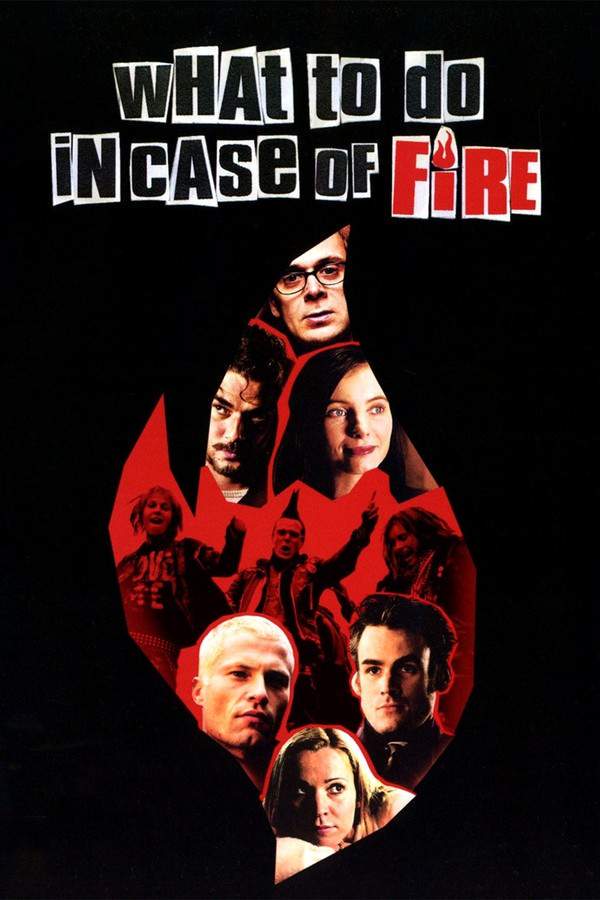What to Do in Case of Fire 2002

A group of former radicals in Berlin are brought back together for a risky mission: stealing damaging video evidence from the authorities. As they attempt the heist, they grapple with their shared history, current personal challenges, and the repercussions of their past actions. The experience forces them to examine their revolutionary ideals and consider whether to embrace a renewed sense of purpose or move forward with their lives.
Does What to Do in Case of Fire have end credit scenes?
No!
What to Do in Case of Fire does not have end credit scenes. You can leave when the credits roll.
Meet the Full Cast and Actors of What to Do in Case of Fire
Explore the complete cast of What to Do in Case of Fire, including both lead and supporting actors. Learn who plays each character, discover their past roles and achievements, and find out what makes this ensemble cast stand out in the world of film and television.
External Links and Streaming Options
Discover where to watch What to Do in Case of Fire online, including streaming platforms, rental options, and official sources. Compare reviews, ratings, and in-depth movie information across sites like TMDb, Wikipedia, Rotten Tomatoes or Metacritic.
Ratings and Reviews for What to Do in Case of Fire
See how What to Do in Case of Fire is rated across major platforms like IMDb, Metacritic, and TMDb. Compare audience scores and critic reviews to understand where What to Do in Case of Fire stands among top-rated movies in its genre.

47
Metascore
3.8
User Score


%
TOMATOMETER

0%
User Score

63
%
User Score
Take the Ultimate What to Do in Case of Fire Movie Quiz
Challenge your knowledge of What to Do in Case of Fire with this fun and interactive movie quiz. Test yourself on key plot points, iconic characters, hidden details, and memorable moments to see how well you really know the film.
What to Do in Case of Fire Quiz: Test your knowledge on the film 'What to Do in Case of Fire' and its themes of rebellion and redemption.
In what year did the characters originally create their propaganda films?
1980
1987
1995
2000
Show hint
Full Plot Summary and Ending Explained for What to Do in Case of Fire
Read the complete plot summary of What to Do in Case of Fire, including all major events, twists, and the full ending explained in detail. Explore key characters, themes, hidden meanings, and everything you need to understand the story from beginning to end.
In 1987, a group of passionate rebels united by a relentless quest for transformation gathered in Berlin’s Kreuzberg district. Within the dilapidated walls of an abandoned building, they crafted plans to challenge the established order through provocative propaganda films. One particular production demonstrated how to create a homemade bomb using easily accessible materials—an act that would resonate through time. This device was concealed in a vacant villa in Grunewald but, due to a timer malfunction, the explosive remained inactive for 12 long years.
Fast forward to the present day, and two of the original insurgents, Tim and Hotte, are still engaged in a low-grade guerrilla campaign against the authorities. Their methods involve a mix of anti-police graffiti, protests against gentrification, and minor thefts. However, their antics come under scrutiny when a real estate broker and potential buyer accidentally unearth the long-dormant bomb, triggering it with their careless interactions. The resulting explosion injures them both, prompting a police manhunt for the so-called “terrorists.”
As they navigate a tangled landscape of alliances and rivalries from their past, Tim and Hotte reconnect with old comrades. Among them is Nele, a dedicated single mother; Terror, a principled lawyer; Maik, a creative director exploiting radical imagery for commercial advertising; and Flo, Tim’s ex-lover, who has seemingly abandoned her rebellious ways for a life of tranquility. By sharing their distressing circumstances, each is forced to reckon with the ramifications of their youthful choices.
Facing potential arrest and a smear campaign, the remaining radicals devise a bold strategy to infiltrate police headquarters, posing as a television news crew. This risky venture holds the promise of reclaiming their lost footage, clearing their names, and rewriting the controversial story of their past. Yet, the stakes are incredibly high, with uncertainty surrounding the outcome.
Tensions rise between Manowsky]( /actor/klaus-lwitsch), a stubborn Berlin officer, and Henkel, a forward-thinking Bonn technocrat focused on public relations. This clash creates an ideal setting for the rebels’ scheme. As Henkel guides the “TV crew” through the precinct, showing them the evidence room containing damning material, Manowsky’s traditional methods put their operation in jeopardy. In a tense moment, the radicals narrowly evade detection during this spontaneous tour.
In a desperate attempt to eliminate incriminating evidence, the group hatches a plot to smuggle a second homemade bomb into the evidence room, disguised as a Trojan horse—a suspicious crate from their old building. They strategically position the device, confident it will be stored alphabetically by location. However, unbeknownst to the others, Hotte will hide inside the crate, ensuring its proper placement.
Complications arise when Hotte, without his wheelchair and forced to use a dolly, becomes trapped in the evidence room after the emergency exit door jams. In a frantic effort to communicate, he attempts to contact his fellow rebels, but everyone seems preoccupied or unreachable. Left with no other choice, Hotte calls Bülent, who is simultaneously trying to convince Tim to abandon their apartment in exchange for a payout for their remaining possessions. Spurred into action, Tim rushes to support Hotte.
Finally, the others receive Hotte’s urgent call and converge on the evidence room for a rescue. However, Manowsky intercepts them just as they believe they can escape. He lectures them condescendingly about their stubborn attachment to outdated ideals, preparing to arrest them. Yet, the timely arrival of the other radicals offers a crucial distraction, allowing them to evade capture.
As events intensify, Tim seizes the moment, securing Manowsky to the evidence cage with his own handcuffs. He threatens to leave the bomb in the officer’s lap but is persuaded by his comrades to refrain from murder. In a dramatic finale, Tim tosses the handcuff keys back to Manowsky, effectively leaving him restrained as alarms blare and the rebels make their daring getaway.
As they flee, an unexpected ally appears in the form of a water cannon, which they utilize to evade the police. Henkel watches, doubtful about the outcome, while Manowsky grapples with a newfound empathy for his former counterparts, reflecting on his old values and the dilemma presented by Henkel’s skepticism. Driven by these wrestling emotions, he makes a pivotal choice: to leave the incriminating bomb in the evidence room, obliterating any evidence against the rebels.
In their escape through the streets of Berlin, the group finds themselves aboard an S-Bahn train, where Tim holds a crucial film to the flame of his lighter. In a moment of deep reflection, he queries, “What do you do if there’s a fire?” to which his companions, in unison, reply, “Let it burn!” This moment echoes their readiness to take daring risks and challenge societal norms.
Viewers can expect a cinematic experience rich in nuanced moments, including instances of mild nudity, drug use, and mature language that add layers to the characters’ journeys and struggles.
Uncover the Details: Timeline, Characters, Themes, and Beyond!

Coming soon on iOS and Android
The Plot Explained Mobile App
From blockbusters to hidden gems — dive into movie stories anytime, anywhere. Save your favorites, discover plots faster, and never miss a twist again.
Sign up to be the first to know when we launch. Your email stays private — always.
Watch Trailers, Clips & Behind-the-Scenes for What to Do in Case of Fire
Watch official trailers, exclusive clips, cast interviews, and behind-the-scenes footage from What to Do in Case of Fire. Dive deeper into the making of the film, its standout moments, and key production insights.
What to Do in Case of Fire Other Names and Titles
Explore the various alternative titles, translations, and other names used for What to Do in Case of Fire across different regions and languages. Understand how the film is marketed and recognized worldwide.
Quick Links: Summary, Cast, Ratings, More

What's After the Movie?
Not sure whether to stay after the credits? Find out!
Explore Our Movie Platform
New Movie Releases (2025)
Famous Movie Actors
Top Film Production Studios
Movie Plot Summaries & Endings
Major Movie Awards & Winners
Best Concert Films & Music Documentaries
Movie Collections and Curated Lists
© 2025 What's After the Movie. All rights reserved.

















